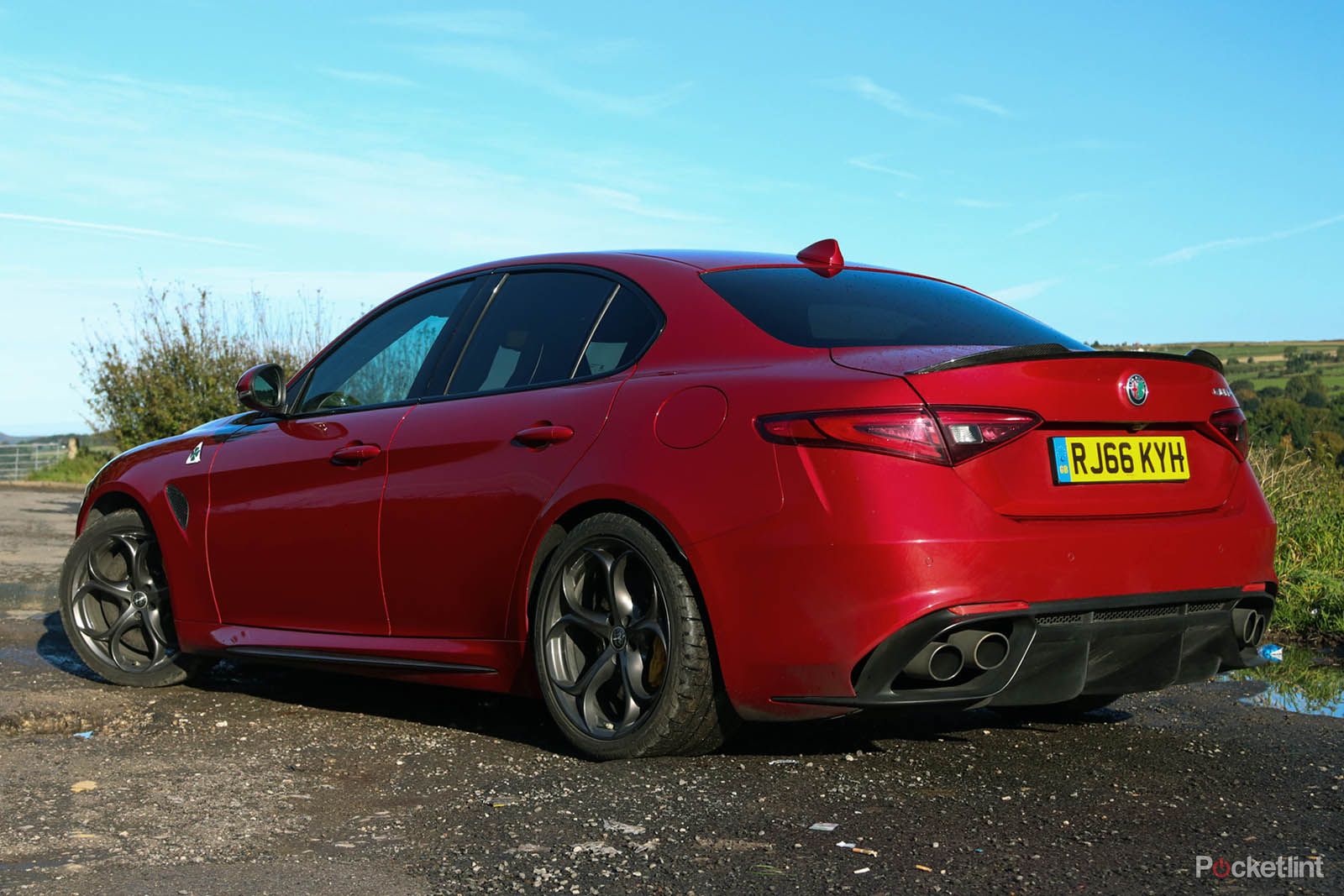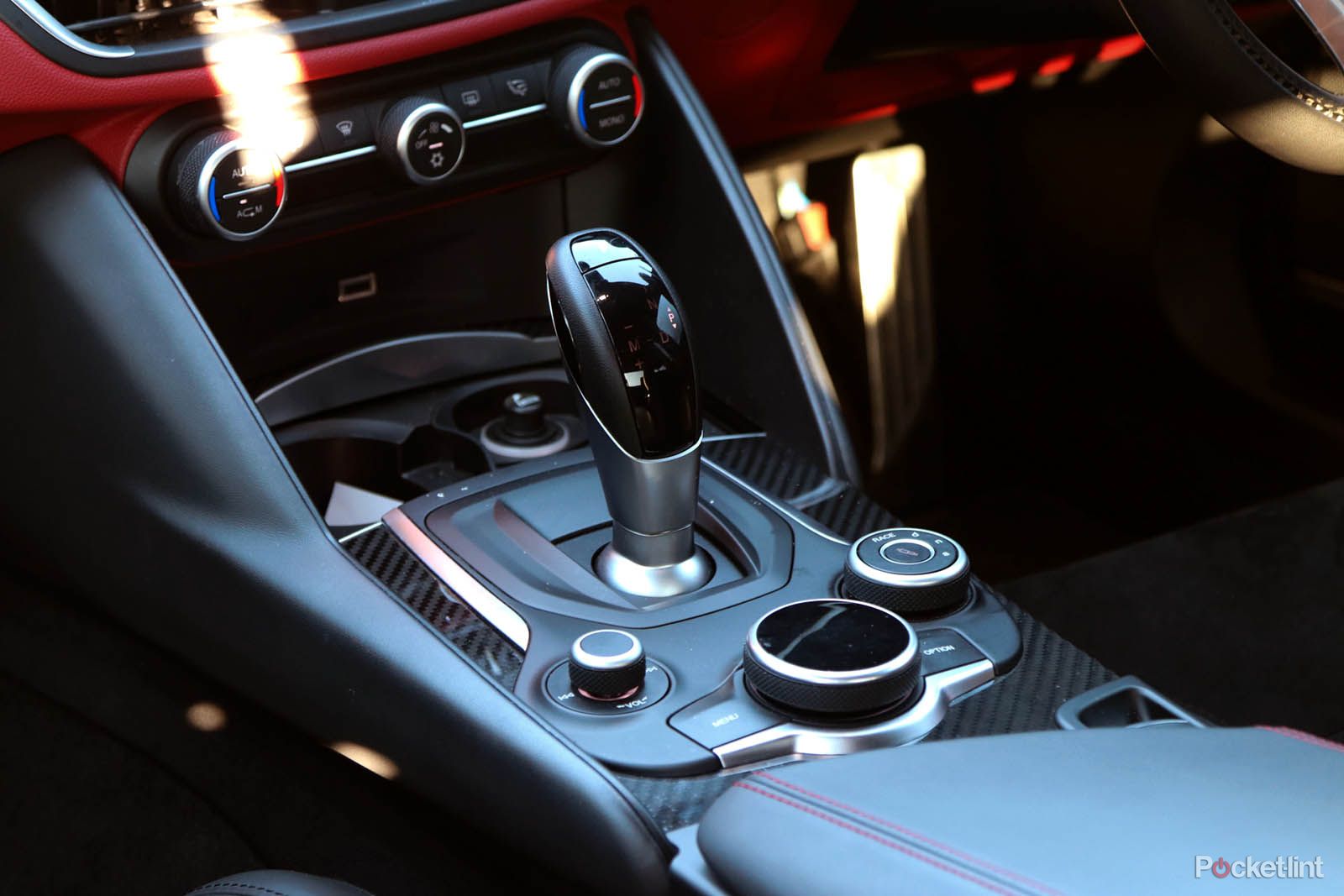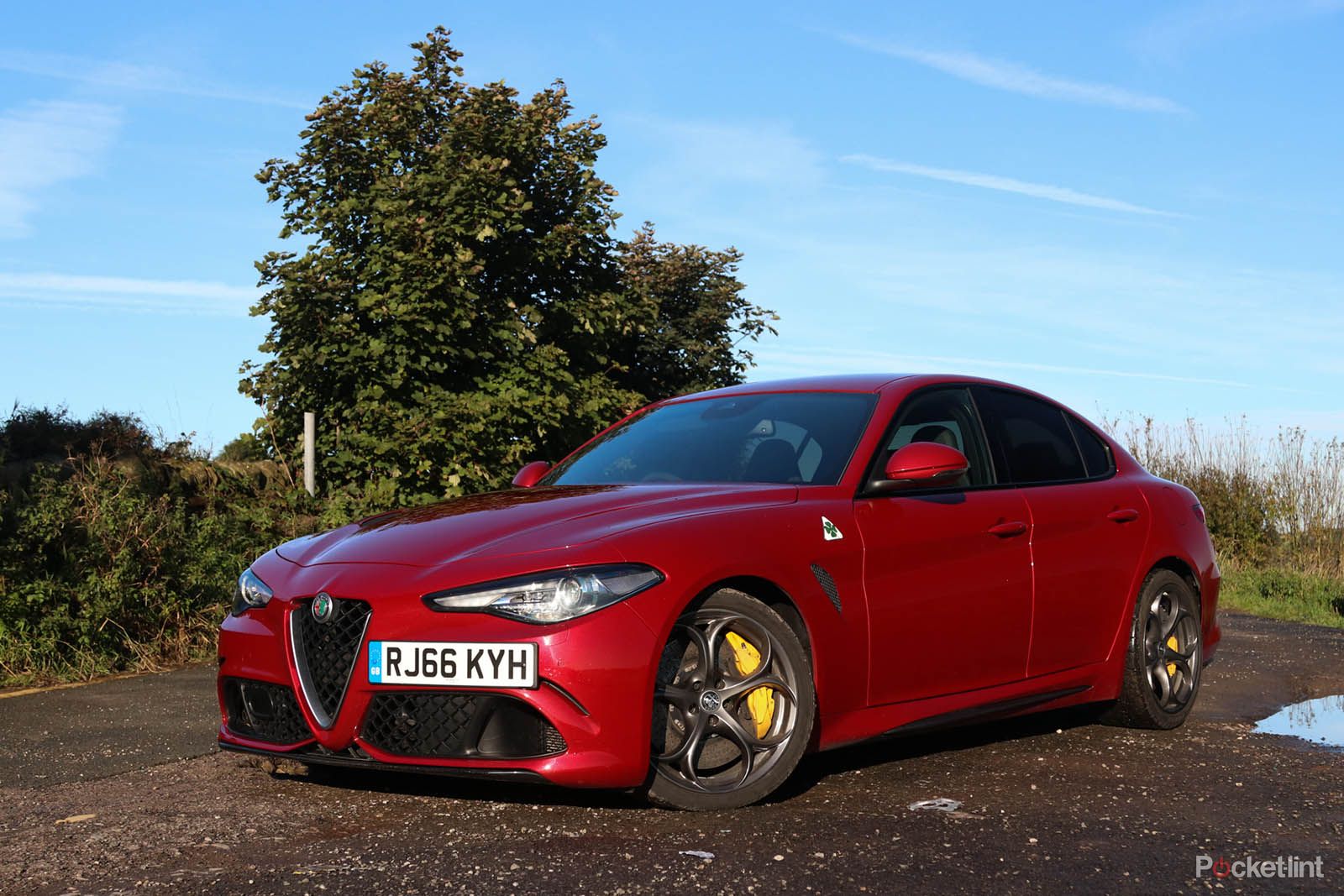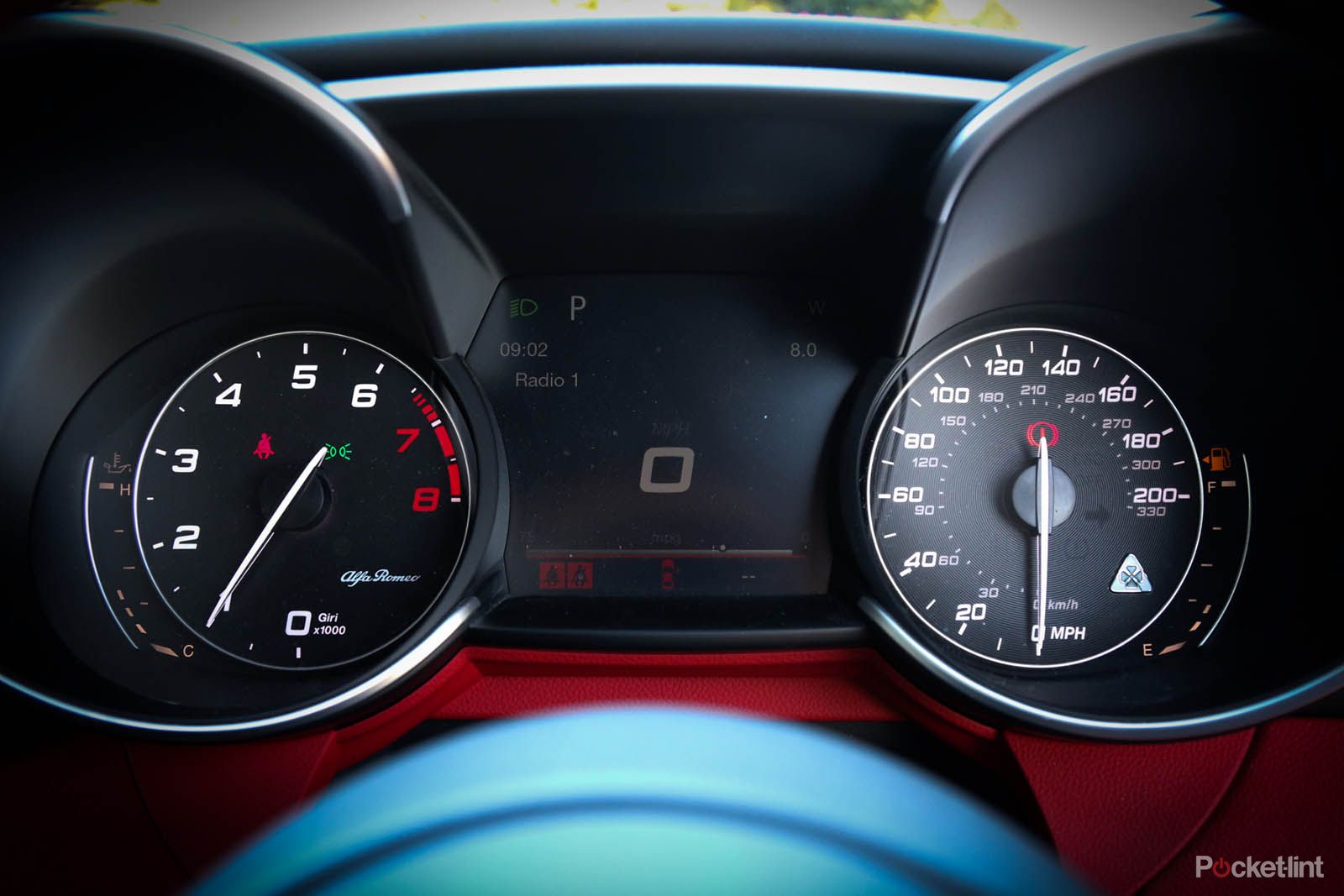How do you define fast?
Our quick take
We had a feeling the most powerful Giulia would be good. Turns out, however, that it's better than good — it's awesome.
The regular car is arguably the best-in-class to drive. That, combined with one of the most evocative badges in car-land stuck on the bonnet, makes the Alfa Romeo saloon a very appealing proposition.
All of the things which make the regular Giulia a very liveable, no-excuses kind of car apply to this performance model too. Only the fantastic teledial wheels (a £695 option) and odd flashes of carbon fibre — plus the massive set of rear exhausts, of course — will mark it out as something special, for those in the know. And judging by the response we got, those in the know really love this car.
Yet it's the way the Giulia Q drives that lifts this car to its lofty star rating. Which is one area the Giulia Q pulls an advantage over its German competition. The steering, handling and ride all feel like they were made for UK roads, while the four-position drive selector scrolls you all the way from sane to brain-out in four easy clicks, transforming the Giulia's character in an instant.
How does Alfa truly play Germany at its own game? By giving the Giulia Q 503bhp and then pricing it at the level as the BMW (which has 437bhp, for the record): £61,595 plays £61,225 for an auto M3 — but the Beemer needs a competition pack to show its best, which adds another £3K. The Alfa also includes a sprinkling of technology and performance parts, such as the carbon fibre bonnet, roof and prop-shaft.
But the numbers game is just half the story. This Alfa feels like it heralds from a world which knows it's the quality of the beans you put in the espresso grinder that matters, not the size of the cup it's poured into or the name over the door. It does the numbers, but wins hands-down on emotional appeal. And by doing so, the Italians have beaten Germany at its own super-saloon game. We didn't think we'd ever write this, but Alfa Romeo has built a BMW M3 beater. It's head and heart wound into one.
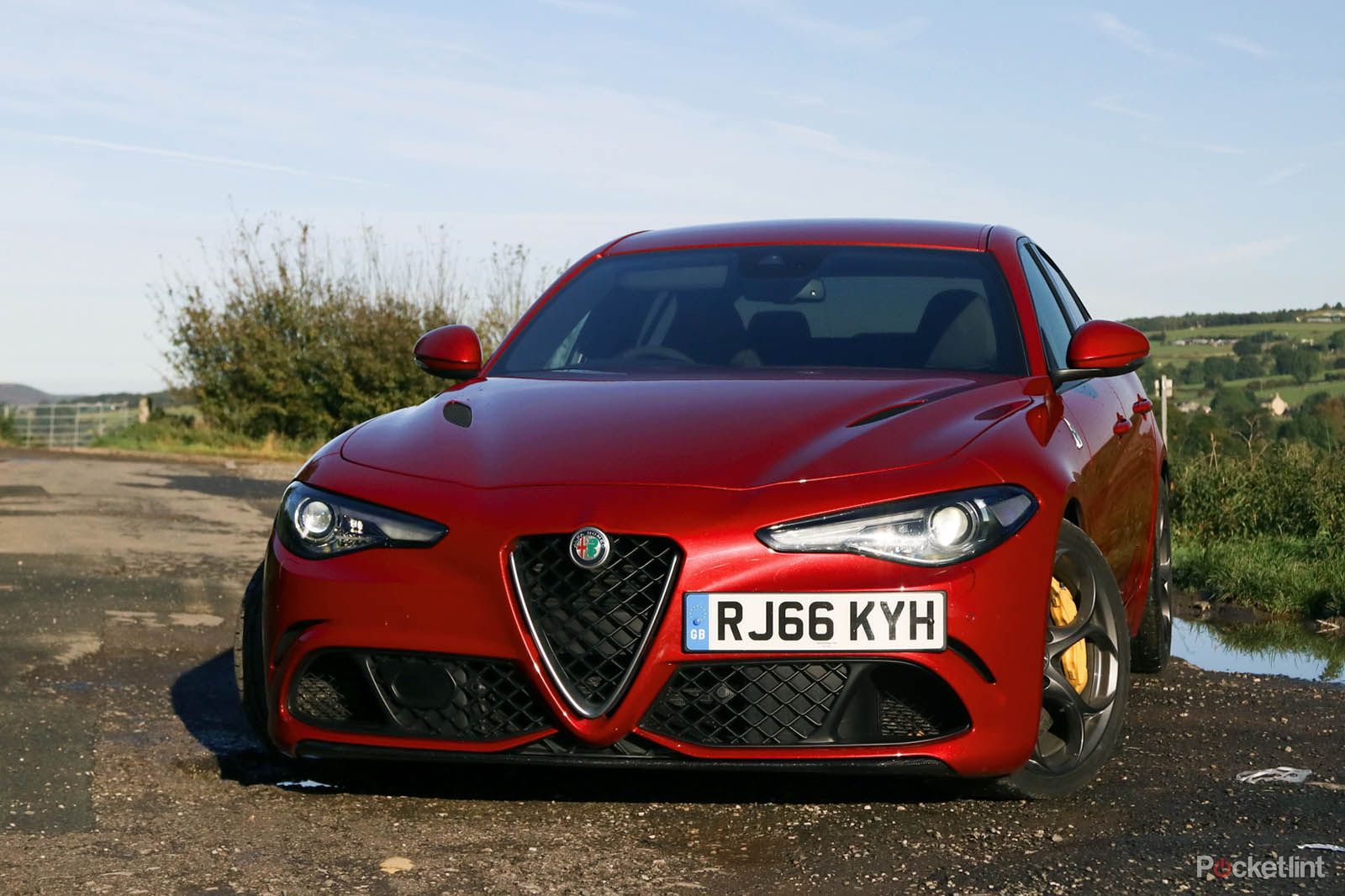
Alfa Romeo Giulia Quadrifoglio - 5.0 / 5
| FOR | AGAINST |
|---|---|
|
|
For some it's a case of bald figures. The Alfa Romeo Giulia Quadrifoglio does 0-60mph in 3.9 seconds and has a top speed of 190mph. So, that's the "head" box ticked.
For others it's defined in less tangible terms. Driving the Alfa Guilia on the commute to work on a cold, wet morning is a bit like having a triple shot of espresso before you've set foot in the office. That's the "heart" box ticked.
Whichever way you define it, there aren't many people who could call an Alfa Giulia Quadrifoglio "slow".
But beyond its speed, Alfa's mid-sized saloon somehow combines both head and heart to more than rival the BMW M3 and Mercedes C63 AMG. Which, given Alfa's sometimes less-than-perfect reputation (at least outside of its die-hard fans, "the Alfisti"), is high praise indeed. But it's fully warranted, for the Quadrifoglio is one rip-roaring car.
Alfa Romeo Giulia Quadrifoglio review: A history of Quadrifoglio
First, a quick history lesson to explain one of the most difficult to pronounce words in the car world.
Quadrifoglio is the Italian word for cloverleaf. Eagle-eyed readers will note that quad denotes "four' — so a four-leaved clover, which is a renowned symbol for good luck.
It won't be a surprise to hear that the term is historically rooted in racing, then. The first cloverleaf was seen in 1923, at the Taga Florio — a historic Italian road race — in which the great pre-war Alfas used to appear, where it was presented to a driver to wish him luck.
Over time, the cloverleaf became the symbol used and associated with racing. More recently that's transferred over to high-performance Alfas.
After a brief history of using Cloverleaf brand as the official designation in the UK, back in the 90s, Alfa realised that in foreign markets, Italian words sound way cooler (even if you can't pronounce them), so has reverted to Quadrifoglio. Rev up those tongues, people.
Alfa Romeo Giulia Quadrifoglio review: The hottest Alfa to date
History lesson over, what you need to know about the latest Quadrifoglio — can't we just refer to it as Q from now on please? — is that it's the hottest modern Alfa to date.
It sports 510 horsepower (or 503bhp) from its twin-turbo charged, V6 petrol engine, which Alfa says is "inspired by Ferrari". No surprise, as a glance at the specification suggests the engine is more than inspired by Ferrari. With the same bore and stroke measurements, we suspect that at least part of this engine might be found under the bonnets of cars wearing a prancing horse.
The power is fed to the road through an 8-speed automatic gearbox, via the rear wheels only. Yep, this is a proper fire-breathing Italian car that doesn't go down the sanitised, four-wheel drive mode of some (if not, increasingly, most) German cars.
The Quadrifoglio is a no-messing-about kind of setup, which means that in the Race mode — which is the extra crazy mode outside of Alfa's "DNA" trio of drive modes (Dynamic, Natural, All-Weather) — all of the electronic aids are switched off, leaving you completely on your own to control how those 510 horses arrive at the road surface. We'll let you imagine the emoticons we'd insert here if we were texting you this information.
Alfa Romeo Guilia Quadrifoglio review: What's it like to drive?
We've been lucky enough to drive plenty of exciting and powerful cars this year at Pocket-Lint. From the sweet Golf GTi Clubsport, to the Green Hell-inspired AMG GT-R, and the bludgeoning new Audi RS5.
It might therefore surprise you to hear us say that the Alfa Giulia Q (yeah, we're going with that naming convention already) is one of the most exciting cars we've driven all year. Possibly the most exciting. Writing this review some three days after the car left us, we think we've put our finger on what it is the Giulia does that elevates it above the others.
It delivers speed in spades. No car that can crack the 60mph acceleration test in under four seconds is ever going to appear in the same sentence as "slow". But the same could be said of countless other cars, including rivals like the BMW M3 and the Mercedes C63 AMG. However, what those cars don't do as well as the Alfa is two core things: they don't entertain quite so well at low speeds; and, as a driver, they don't make you the centre of the action in the same way as the Giulia Q.
What do we mean by this? When driving slowly, the Giulia feels like it's on a leash — it wants to go fast, so you have to exercise restraint to stop yourself speeding or being silly. However, even if you're going quite slowly, putting the car in Dynamic or Race modes makes the response of the accelerator pin-sharp and wakes up the noisy exhaust, which sends all kinds of meliflous tones through the cabin once the revs climb over 3,000rpm.
Core to the experience is that you're sat low in the car, in a fabulous Sparco-branded bucket seat with carbon-fibre back. These £3,250 optional extras are one of the best interior things about our test car, and should be an option box you tick because they make it feel like driving a Touring Car, rather than a road-going Alfa saloon.
The other factor is the steering. As we said with the regular Giulia we drove earlier in the summer, at first it feels very light (strangely so if you've stepped out of a BMW M3), but there is loads of feedback and the rack is very quick as there aren't many turns lock-to-lock. All that means the Alfa darts into corners really keenly and feels very alive.
Add to this the small-scale steering wheel, covered in Alcantara and carbon fibre (for the princely sum of £425, of course), the perfect driving position, and the massive Ferrari-sourced cold-to-touch gearshift paddles, and every journey becomes an event. It's different to the BMW in particular, because in the M3 there's a certain aloof quality to the car — it's insulating and feels like it doesn't always need you to be on your game to go down the road smoothly.
In the Alfa, anything but that is true. Despite it having an auto gearbox, you need to manage accelerator inputs and change gear at the right point or it can all feel a bit jerky. We can imagine that this might make you tire of the Alfa over time — but the truth is that after 500 miles of driving we hadn't once grown annoyed by it.
Indeed, on a long motorway journey the 8-gears of the automatic gearbox, comfortable seat and the expensive, independent rear suspension setup means that the Alfa Q is quite a refined and comfortable cruiser. It even did over 30mpg in this context.
Alfa Romeo Giulia Quadrifoglio review: is it better than a BMW M3?
No car is perfect. Yet drive a modern BMW, Audi or Mercedes and it's hard to come away without the sense that they're as close to perfect as can be.
Which, if your name is Alfa Romeo, could be something of a problem. Because an Alfa is a choice driven by passion and emotion — you buy it because it has character. Character is created, in part, by the things that aren't perfect.
The Guilia Q isn't perfect, but that's almost why it's so attractive. The switchgear in the cabin is cheap, the interface works pretty much like a BMW-meets-Mercedes setup — but is slower to respond and looks like someone deliberately limited the colour palette. The car beeps at you when you lock and unlock it, like an old 90s American car. You can't independently configure different parts of the drive system, such as steering, accelerator response, and electronic aids. The fuel gauge appears to be operating on the Donald Trump White House staff scale of "truth telling" (despite reasonable miles-per-gallon based on our at-the-pump input). And our car also came with optional £5,500 carbon-ceramic brakes that felt like they were very well used at 14,000 miles deep (so we'd steer clear of that option).
How much does all of this matter? Not all that much, in truth. As we mentioned in our main Giulia review, Alfa clearly benchmarked the BMW 3 Series when developing the Giulia, and although some parts like the switchgear fall into the category of poor imitation, in general if you're choosing a car to learn from and follow, the 3 Series is better than most.
In the Alfa Q there's a decent boot space (though the opening is small); there's space for two people in the back (Quadrifoglio models come with only two rear seats, though, so this isn't a five-seater); and there's a total of three USB ports front and back, plus a digital radio and cruise control.
Yes, the camera image when reversing is small, only one of the two front cup-holders can accommodate a coffee cup and if you use it you can't control the aircon. Y'know, small details.
But the Giulia Q has got what's needed to make it easy to live with. It's inoffensive, it doesn't scream and shout for attention and, if put in All-Weather or Natural mode then it's spot-on to take the kids to school, do the commute, bring grandmother round for tea, or other such journeys — all without causing anyone the need to raise an eyebrow.
Yet when you want it to be, it's the most visceral and enjoyable thing to drive; it's a car that truly puts you in control; a car that (in Dynamic and Race modes at least) has an almost instinctive, feral like response to throttle inputs; and it sounds absolutely superb as it closes in on the 7,300rpm redline.
It rides very well on British roads too — almost like it was developed here. Because, notably, the one aspect Alfa gives you independent control of in the drive setup is the suspension settings. In Race or Dynamic mode, hitting the Damper button in the middle of the drive selector puts the damper into Comfort or Mid setting, allowing the Giulia Q to breathe with even the craziest bumpy road underneath it.
And then you can flick into Race mode and switch all the electronic systems off at a stroke and... well, the Giulia will indulge brain-out powerslides for as long as you dare. Or until you run out of talent, at least.
To recap
Alfa’s inspired-by-Ferrari super saloon takes the game to the big German brands, and beats them. Cleverly covers off the day-to-day liveable bits of car design, and throws in a drive that feels only a rung-below modern day Ferraris.

